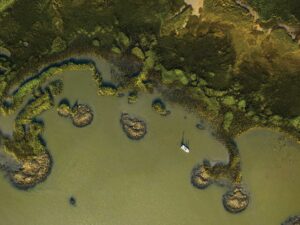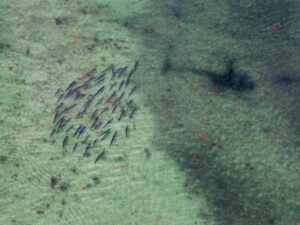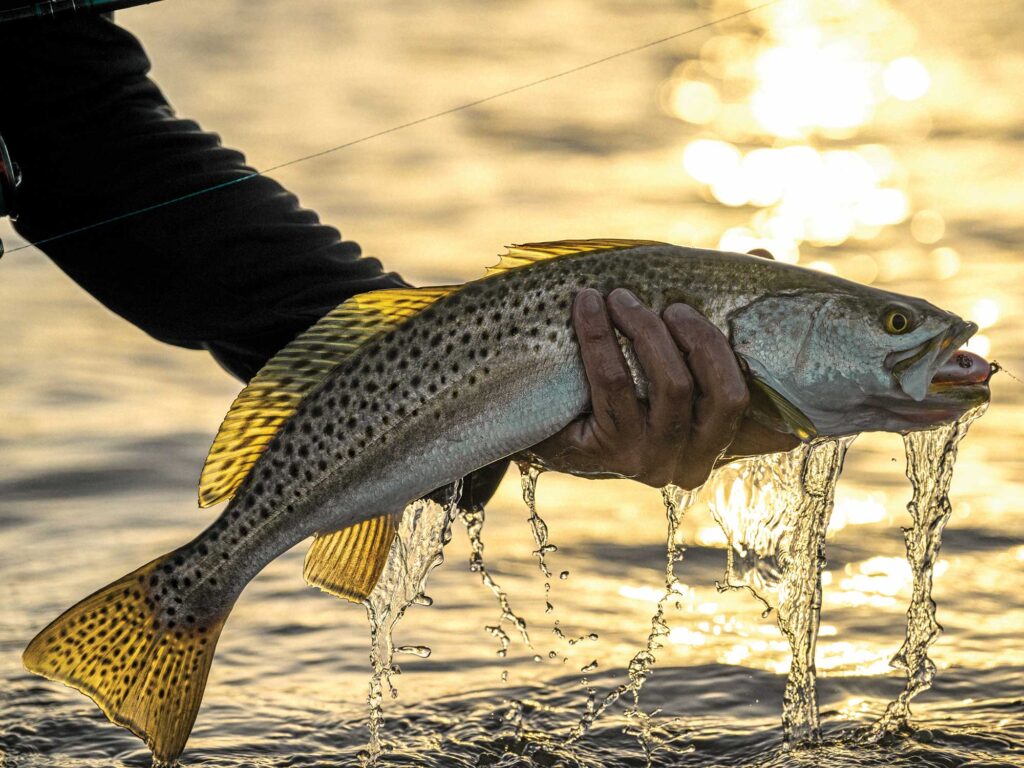
A cavalcade of species migrate in and out of the mid-Atlantic’s local estuaries as the seasons change. Take, for instance, the spotted seatrout. It can be found in North Carolina’s coastal waters year-round, but moves as the winds shift and the waters cool down each year. A sea-trout’s behavior may seem challenging to understand, as environmental factors influence their movements, but anglers who pay attention to the speck’s migratory patterns can target them successfully as they travel from here to there and back again.
Fall: Here Comes the Chill
Many anglers consider October and November official trout season, as the fish start to school up by size class. These schools are not hard to find if you focus on the fish’s habitat needs. During the fall and early winter, trout are searching for consistent water temperatures and plenty of opportunities to feed while there is still ample bait in the area. Fishing with artificial lures during the fall can produce epic days when anglers lose sight of their catch stats.
During the mullet run each fall along the mid-Atlantic seaboard, a lot of trout stage on structure such as jetties and around bridges. Another key thing to look for is well-developed oyster bars that form along the intertidal zones. Trout like moving water, and anything that breaks the current can hold fish. They tend to stage in zones, where they take full advantage of opportunities to feed on prey items flushed from the local inlets each fall, specifically mullet at the beginning of their southward migration.
Marsh points often carve out deep holes, especially in areas where two bodies of water converge with good tidal flow. Tidal creeks that empty into larger bodies of water can be especially productive because they provide the fish with more stable water temperatures as the seasons change. Sometimes you must check several spots to find trout, but typically, once you catch one, you’ll catch more.
I prefer to scout shorelines during lower tidal stages and come back once the water has risen. I especially like the beginning of the falling tide because a lot of bait, like mullet and small shrimp, gets flushed out of the marsh grass. Look for the areas where you see water funneling out of the marsh; these provide ambush zones for big schools of feeding trout. Some days they feed on the surface, others days on the bottom, so fish the entire water column with a variety of lures. Soft plastics and artificial shrimp can be very productive.
If we have a mild fall, this pattern can hold for several months, well into the winter season. As the water temperature continues to drop, the key is finding zones that do not experience big temperature swings. Seek out areas that provide stable water temperatures, like the backs of coastal creeks where seatrout sit in deep holes until spring. Some specks will hold in the surf over winter along our beaches because the ocean is usually a few degrees warmer.
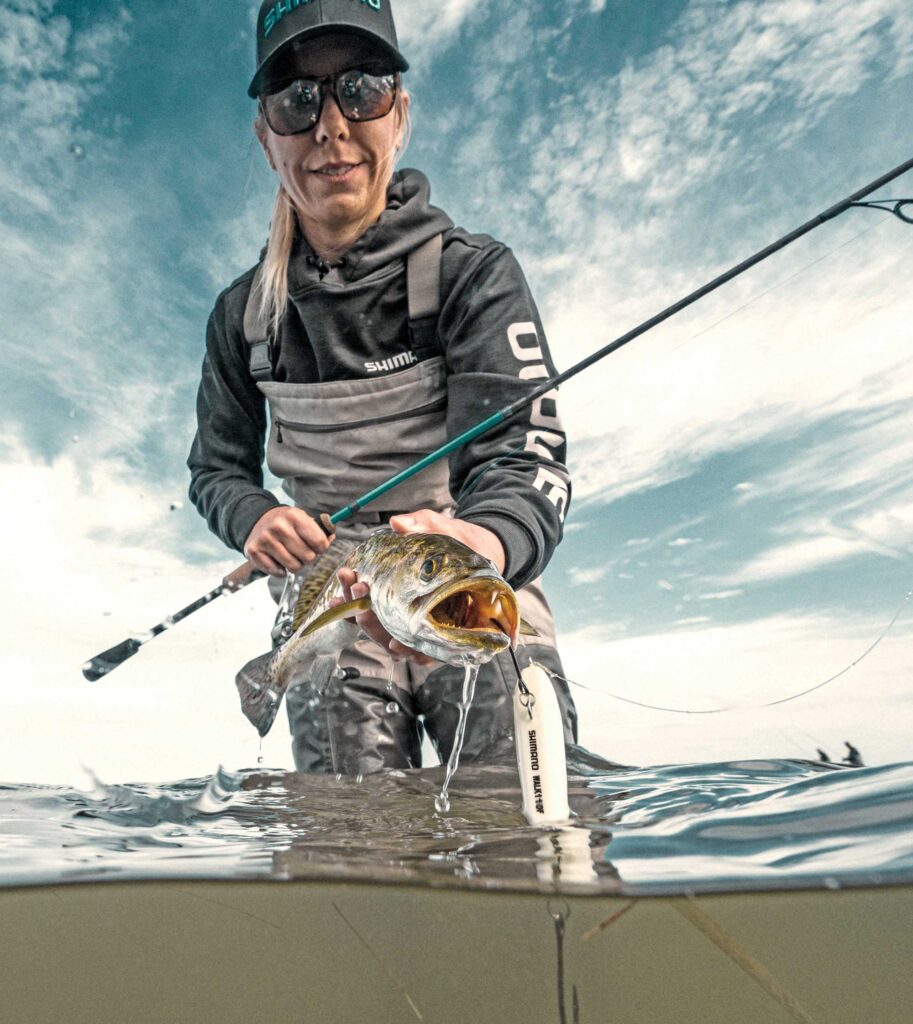
Winter: Slow It Down
Anglers who follow the fish can catch trout consistently through the colder months utilizing a variety of slow-sinking twitchbaits that suspend in the water column, often enticing a strike. The best bet for cold-water trout is to slow everything down and be prepared for a very subtle bite because the fish won’t exert a lot of energy to chase down a lure. I like to scale down the size of my lures because a lot of the winter bait tends to be much smaller.
Spring: The Spawn Is On
As solstice gives way to equinox, trout are on the move—their instinctive drive to procreate takes over. Once water temperatures start to rise again in late April and early May, they head out of the creeks and begin to push into shallow, higher-salinity waters near inlets, searching for their primary spawning habitats. They continue to seek out water with good tidal flow because they depend on larval transport to disperse their offspring throughout the region. Grass flats, shoals and oyster bars in 1 to 3 feet of water can be especially productive.
Look for subtle edges and submerged drop-offs that border hard-packed shoals. During lower tidal stages, trout tend to concentrate in the slightly deeper water, waiting to return to the flats as the tide pushes back in. At high tide the fish scatter on the flats, but at low tide they sit in queue along the edges, waiting for enough water to get back to where they want to be. Sometimes a difference of as little as 6 inches of water is all it takes to make them comfortable enough to ride out the lower tide cycle.
Read Next: Seven Top Tips for Landing Large Seatrout
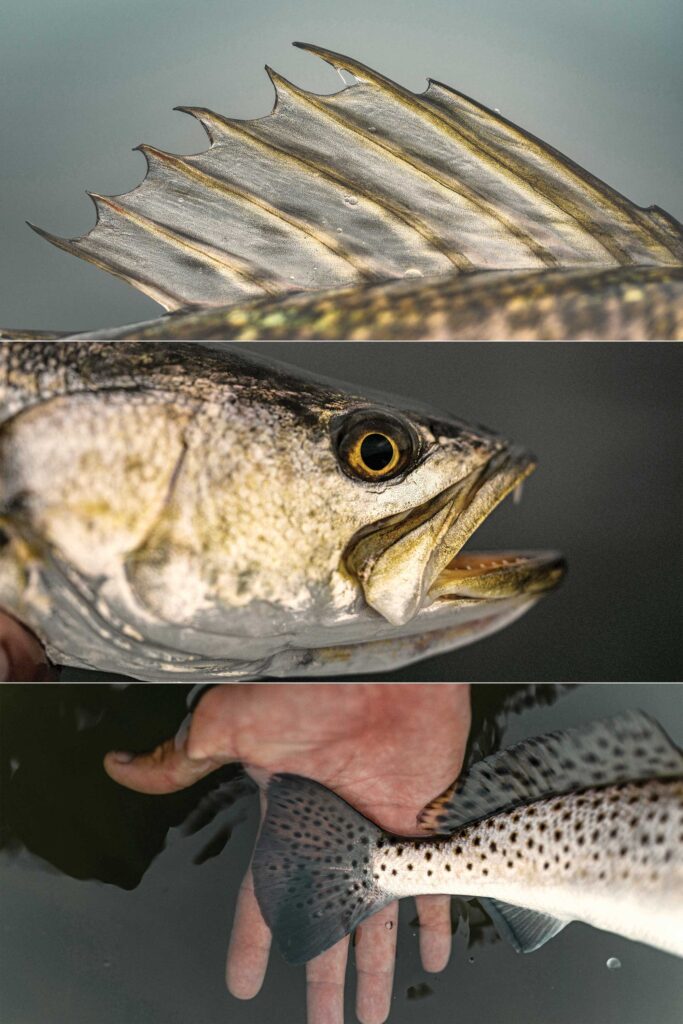
Summer: Topwaters on the Flats
The best bite during spring and summer always seems to be right before sunrise, so it requires commitment to get to the productive spot before the trout’s morning feed. If you’re pulling up to the spot once the sun is up on the horizon, you’d swear there are no fish around.
Since spawning fish tend to spread out instead of schooling up, having success with trout during the summer is more about the angler’s approach than anything else. Shallow water leads to spooky fish. An angler’s ability to move with stealth is essential. Wade the flats when possible. When I must stay on the boat, I use the trolling motor—sparsely. Try to use current and wind to push you into the zone, and apply short pulses with the motor when you need to make course adjustments. A kayak is another good way to remain mobile but stay as quiet as possible.
When targeting trout up on the flats during spring and summer, I love to utilize a surface plug. It’s no secret that topwater lures catch more big trout during summer than any other design. With a long cast out into deeper water, a topwater is the perfect search bait for laid-up trout waiting to push back up on a tidal flat.
I honestly don’t feel like the lure color matters as much as the angler’s ability to impart the proper action. Keep the lure moving with a steady retrieve, ensuring the lure is making plenty of noise as it glides along the surface. The constant side-to-side, walk-the-dog-style action turns on a trout’s instinctive desire to feed on an injured baitfish struggling to swim on the surface.
Constant sound is another factor that seems to ignite the strike. When it’s too windy to effectively utilize a topwater, a good backup plan is a scented soft plastic underneath a popping cork. Make a long cast, give it a couple of good pops, and let it drift in the current.
Anglers Make an Impact
Speckled trout have a cultlike following, leading to a lot of pressure on the fishery year-round. Thanks to advocacy groups like Release Over 20 and Speckled Truth, more and more anglers are taking responsibility and promoting wise use of the resource.
Many fishermen choose to release larger trout to benefit the future of the fishery. A five-year-old trout between 22 and 24 inches can produce five times as many eggs per season as a two-year-old fish between 14 and 18 inches. Research indicates that a 20-inch trout can spawn over 20 million eggs each season.
There are also habitat restoration projects specifically designed for protecting the sensitive areas that trout frequent. The North Carolina Coastal Federation has been working with fishermen for several years to restore oyster reefs and native marsh grasses along the coast.
By practicing responsible catch-and-release techniques and protecting our estuarine environments from further degradation, we are supporting a thriving fishery worth millions of dollars to local fishing communities. This work helps ensure that future generations can experience a healthy fishery—no matter which season they choose.



